Jose
R. Capablanca (2775)
- Alexander A. Alekhine (2745)
[D52]
World
Championship Match in Buenos Aires,
Argentina. (Game # 11), 1927.
The
game began with the moves:
1. d4, d5; 2. c4, e6; 3. Nc3, Nf6; 4. Bg5, Nbd7;
5. e3, c6; 6. Nf3, Qa5; 7. Nd2.
***
7.
Nd2, was the move played in the game.
But White does have other moves that he can play here.
***
We
now analyze some (or all) of the [main] alternatives to 7. Nd2.
The alternatives are:
Variation # 1.):
7.
cxd5, '!' - Best, according to Kasparov.
7...Nxd5;
8. Qd2, N7b6; {'!'}
***
(See the
diagram below.)
***
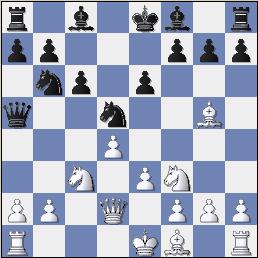
(The position following the move 8...N/7-b6. Analysis
Diagram.)
***
(Not
the only move, but considered the best line by many books!)
***
{8...N/7-b6;
is not the only move here. Black can also play
8...Bb4.}
***
History
repeated itself with: 8...Bb4!?;
9. Rc1 0-0;
***
Or
9...h6!? [Maybe this is the
best? - A.J.G.]
***
{See diagram directly below.}
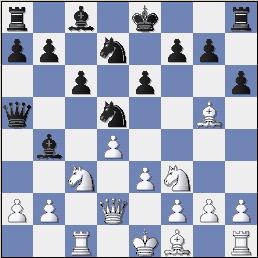
(Analysis diagram after 9...h6.)
***
10.
Bh4 c5; 11. a3 Bxc3; 12. bxc3 Qxa3; 13. e4 N5f6;
14. Bd3 Qa5; 15. d5 c4!?; 16. Bxc4 exd5; 17. Bxd5,
White is clearly a little better. ("+/=")
***
(See the diagram below.)
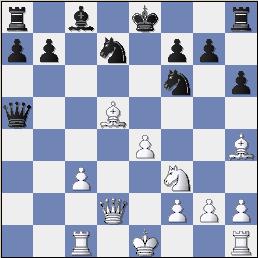
(Analysis Diagram after 17. Bxd5.)
***
M.
Gurevich - Cardon; Belgium, 1994.
***
[ See MCO-14; pg.'s # 406-407,
Columns # 41 through column # 42; and note # (r.). ]
***
10.
Bd3 h6!?;
***
(Nunn gives 10...h6 an exclamation point.)
[
See NCO; pg. # 415, line/row # 3. ]
***
*
Remember
this position after 10...h6. We shall return to it later. *
But
first we shall look at another game of great interest to this line.
***
(The
game of historical significance
continued in this line.)
***
Also
interesting is: 10...e5!; (Maybe - '!?')
***
[See the diagram below.]
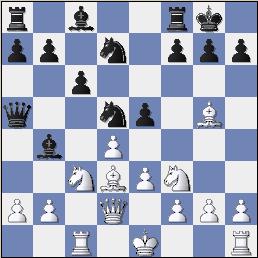
(Black just played 10...e5.)
***
(This
move, 10...e5; is considered
by many opening analysts
to be the best move here. It is certainly one of the more
energetic options, immediately striking at the center.) {A.J.G.}
***
11.
0-0 exd4; 12.exd4 f6!?;
***
But NOT
12...N7f6?!;
***
(MCO does not give Black's 12th move a mark of any kind.
But it must be bad, considering the outcome.)
***
13. Rfe1 h6; 14. Bxh6!,
***
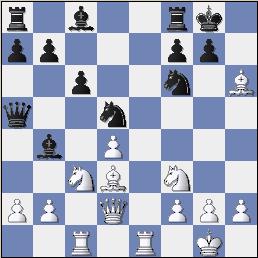
(White just
played 14. Bxh6. See the diagram just above.) ***
The
position is better for White. ("Plus over a line," or "+/".)
***
This
is clearly better [very good] for White, according to GM Kasparov.
[
See
MCO-14; pg.'s # 406-407, column # 42, and note # (u.). ]
***
13. Bh4, Rd8;
(The end of column # 42 of MCO-14. See the diagram
just below.)
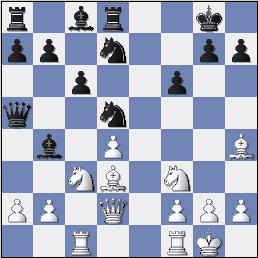
(Opening analysis position after MCO's 13...Rd8.)
***
What should White
play?
***
***
***
(Main analysis Diagram, # 1.)
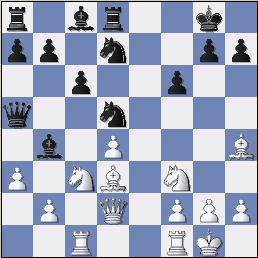
(The position after 14. a3!)
***
Now
14.a3! ,
***
("Plus over an equal sign," or
"+/=".)
(White is better, according to Kasparov.)
***
This
is the game, GM Garry Kasparov - GM Vassily Smyslov;
FIDE World Championship's Challenger Final, Game # 3, Vilnius; 1984.
[
See MCO - 14; page 407, and the very lengthy note (v).
]
***
[ See also,
"The Test of Time,"
by Garry Kasparov.
Chap. # 22, page # 210. ] *** NOTE:
This was the first time
(that I could find), that this opening;
[The
Cambridge Springs Defense.]
had made an
appearance at the highest
level
in well-over 50 years!
***
Or
White can play: 14. Qc2 Nf8; 15. Nxd5 cxd5; 16. Bg3 Bd6;
("The position is equal," or "="
.)
***
(Now see the diagram directly below.)
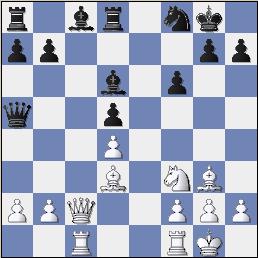
( Black plays 16...Bd6; {"="} in the
Cambridge Springs.)
***
And
Black has equalized, according to GM N. DeFirmian.
[ See MCO-14; pg.'s # 406-407, column # 42; and note #
(v.). ]
***
Now
after 14. a3!, Black can play: 14...Bxc3;
*** Or:
Black can also play: 14...Bd6;
15. Nxd5 Qxd2; 16. Nxf6+ Nxf6;
17. Nxd2 Bf4; 18. Rcd1 Rxd4; 19. Nf3,
White is just a little better.
("+/=") *** (See the diagram
directly below.)
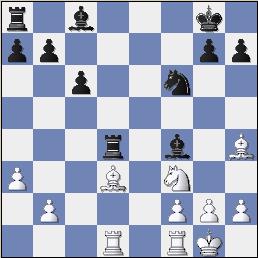
(Analysis
diagram after 19. Nf3.)
***
Kasparov
judges this position to be clearly better [superior] for White.
***
[
See MCO-14; pg.'s # 406-407, column # 42, and note # (v.). ] *** 15.
bxc3, Nf8; *** OR:
15...Qxa3!?; ('?!') 16. c4, (
White
is clearly better. "+/=" or "+/"
) *** (See
the diagram directly below.)
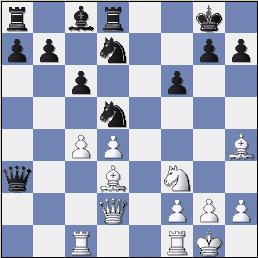
(Analysis position after White's 16th move.)
***
"
... with a big edge for White,"
according to GM N. DeFirmian.
[ See MCO-14; pg.'s # 406-407, column # 42; and note # (v.). ]
(White may be threatening to play c5 and try to trap Black's Queen.) {A.J.G.}
***
Now the players
[in the remainder of the game,
Kasparov-Smyslov]
continued:
16. Bg3, - White is clearly better. ("+/")
16...Be6; 17. Rfe1 Bf7;
18. c4 Qxd2; 19. Nxd2 Nb6; 20. Nb3 Na4; 21. Bf1 Rd7;
22. Na5 Ne6; 23. d5! Nd4; 24. dxc6 Nxc6; 25. Nxc6 bxc6;
26. c5 Re8; 27. Rxe8+ Bxe8; 28. Bd6 Bf7; 29. Rb1 Bd5;
30. Rb8+ Kf7; 31. Rf8+ Ke6!?; 32. g3 g6; 33. Ba6 Rxd6;
(!?)
***
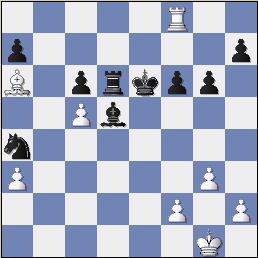
(Analysis Diagram
after 33...Rxd6.)
***
Desperation. White threatened Bc8, pinning
Black's Rook and
winning the exchange. There was probably no good defense here.
(A.J.G.)
***
34. cxd6 Kxd6; 35. Rxf6+ Ke5; 36. Rf8
c5;
37. Re8+ Kd4; 38. Rd8 Ke5; 39. f4+ Ke4; 40. Bf1,
***
Not the only winning move
here.
(40.
Rd7!? "+/-" ) {A.J.G.}
***
40...Bb3;
41. Kf2 Nb2;
** *
(Second main analysis
diagram.)
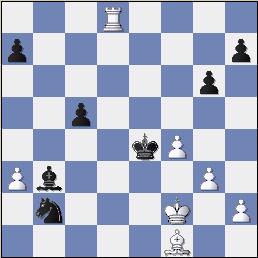
(The analysis position from G. Kasparov - V. Smyslov;
Black just played 41...Nb2)
** *
"
... and White [eventually] won. Filigree technique
by Kasparov."
- GM N. DeFirmian in MCO-14.
Kasparov - Smyslov;
Vilnius, Lithuania,1984.
(FIDE World Championship Candidates Match)
***
[
See MCO-14; pg.'s # 406-407, column # 42; and note # (v.).
]
*** A
game of great historical importance, at least from a chess-player's point of
view. A game that is also key to the Cambridge Spring's Defense. It is also
critical to the theory and to understanding the 10...e5!? line. *** Right
now the ball is in BLACK's court ... it is up to
the second player to find an improvement (s) in this line. Maybe you are the one
who will change the "Book" and help Black out ?
( The first 10 moves were: 1. d4, d5;
2. c4, e6; 3. Nc3, Nf6;
4. Bg5, Nbd7; 5. e3, c6; 6. Nf3, Qa5; ('!') 7. cxd5, Nxd5;
8. Qd2, Bb4!?; 9. Rc1, 0-0; 10. Bd3, h6!; )
***
(In
this line Black
played 10...h6; instead of 10...e5;
as in the Kasparov-Smyslov
game.)
***
Now
White can play:
11.
Bh4 e5; 12.a3!?,
***
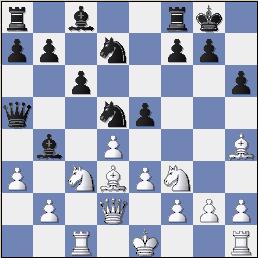
(Analysis Diagram. White just played 12. a3.)
***
The position after
12. a3!? Now there is a parting in the paths.
***
(Start
of MCO analysis, beginning at move 12.)
***
Or
Instead of 12. a3!?, White can also castle.
***
So
MCO-14 gives: 12. 0-0, exd4; 13. exd4 Re8;
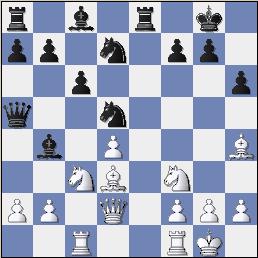
(Analysis Diagram. The position after 13...Re8.)
***
[The end of column # 41, MCO-14, pg.
# 406.]
***
14. Bb1 Nf8; 15. Ne5
Be6;
***
And now there are
a couple of different
tries
by White for an advantage: 16.Qd3,
(!?)
***

(Analysis Diagram after MCO's 17. Nf3.)
*** Or
16. Rfe1, c5;
and now
17.
Nf3,
("+/=")
(White is just a little
better.)
***
{See
the diagram directly above.}
***
This
line is GM Smagin's recommendation.
***
[ See MCO - 14; pg.'s # 406-407, column # 42; and note #
(t.). ]
***
But not
17.
Nc4?,
***
Bad - a clear loss of time; ... AND it drops a pawn. {A.J.G.}
Now 17...Qa6; 18. Ne3 Nxe3; 19. fxe3 Bxa2;
"Black is clearly better." [Plus under a line, or
"/+".]
***
{See
the diagram directly below.}
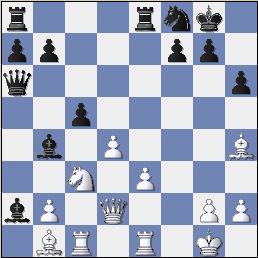
(MCO analysis position after 19...Bxa2.)
***
Oll-Smagin;
Copenhagen, 1993.
***
[ See MCO-14; pg.'s # 406-407, column # 42; and note # (t.). ]
***
(After 16. Qd3,
we now have:)
***
16...Nf4; 17. Qf3 N4g6; 18. Bg3 NxN/e5;
***
(The
position is equal. "=" )
***
{See
the diagram directly below.}
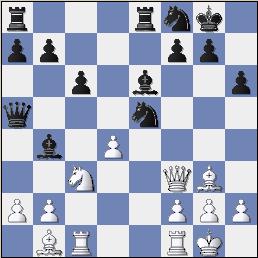
(Analysis Diagram after 16...Nxe5.)
***
Uhlmann-Smagin;
Dortmund, 1991.
***
[ See MCO 14; page 406, column # 41, and note (t). ]
***
This seems to be one of the
better lines for Black.
It would
also seem to indicate that 16. Qd3!? is a rather lackluster move for White.
{A.J.G.}
* **
(The end of the MCO analysis that began at move
12.)
Returning to the NCO (Nunn's) analysis -
( The first 10 moves were: 1. d4, d5;
2. c4, e6; 3. Nc3, Nf6;
4. Bg5, Nbd7; 5. e3, c6; 6. Nf3, Qa5; ('!') 7. cxd5, Nxd5;
8. Qd2, Bb4!?; 9. Rc1, 0-0; 10. Bd3, h6!; ['!?'] )
***
and then
White can play: 11.
Bh4 e5; 12.a3!?,
-
so we
continue 12...Bxc3;
("=") 13. bxc3 Re8;
***
Or:
13...exd4; 14. cxd4 Qxa3; 15. 0-0 Re8;
***
Rogers-Smagin; Prague, 1992.
***
[ See MCO-14; pg.'s # 406-407,
columns # 41 through column # 42; and note # (s.). ]
***
Ftacnik
[now] suggests: 16. e4 N5b6; 17. Rfe1; [Unclear]
***
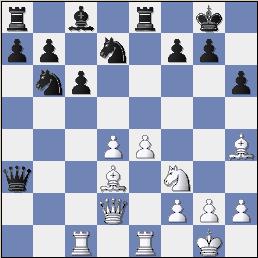
(The
analysis position after 17. Rfe1.)
***
"It
is unclear whether White has enough compensation for the pawn."
- GM N. DeFirmian.
***
[
See
MCO-14; pg.'s # 406-407,
columns # 41 through column # 42;
{Mainly column # 41.} and note # (s.). ]
***
14.
c4 Qxd2+; 15. Nxd2 Ne7; 16. 0-0,
***
Or 16. Bxe7 Rxe7; 17. d5 Nc5;
[Unclear]
***
16...exd4; 17. exd4 Nf8; 18. Rfe1 Bf5;
(The position is equal.) ("=")
***
{See
the diagram below.}
***
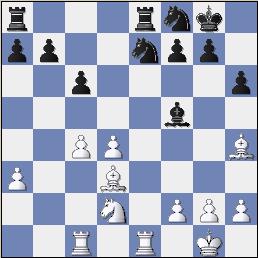
(NCO analysis position after 18...Bf5;
'"=".)
***
[ See
NCO; pg.'s 415-416, line/row #3, note # 19. ]
(Back to the analysis
of 7. cxd5 (!), 7...cxd5; 8. Qd2, N7b6;)
***
It is worth
repeating here that the majority of the opening books
today consider this move, 8...N/7-b6; to be the best move.
***
9.
Bd3 Nxc3; 10. bxc3 Na4; 11. 0-0 Qxc3; 12. Qe2 Qb2;
(And now according to GM John Nunn,
White has some compensation for the
material sacrificed; the position could also be classified as unclear.)
***
[ The end of line/row # 3, page # 415. Nunn's Chess Openings; or
NCO. ]
***
13.
Bc2 Qb5; 14. Qd1,
***
14. Bd3 Qb2;
transposes to 12...Qb2;
and is offering to
repeat the position. I.e. 15. Bc2, Qb5; 16. Bd3, Qb2; etc. - {A.J.G.}
***
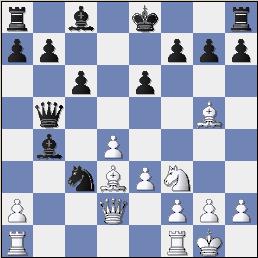
(The position following Nunn's 16. Bd3.)
***
14...Nc3;
15. Qd2 Bb4; 16. Bd3,
"White
has some compensation for the pawn that he sacrificed."
- GM John Nunn.
***
{See the diagram directly above.}
***
[ See
N.C.O; pg.'s 415-416, line/row # 2, and note # 15. ]
Variations
# 2 through # 5.
***
Some moves that
are not quite satisfactory, according to theory, are:
***
Variation # 2.):
7.
Bd3? dxc4; 8. Bxc4 Ne4;
and Black is clearly better; "/+",
or
"a plus under a line."
(Maybe
"-/+" ?)
***
Or Variation # 3.):
7.
Qc2!? (?!) 7...Ne4; ("=")
Black is at least equal, if not a little better. {A.J.G.}
***
Variation #
4.) 7. Bxf6!?, Nxf6; 8. Nd2,
[ Or
8. Bd3, Bb4, 9. Qb3, dxc4; 10. Bxc4, b5!?; ("=")
(Maybe 10...c5!?) ]
(Now
after 8. Nd2) 8...Be7; ("=") (Or
maybe 8...g6!?)
***
Or Variation # 5.):
7.
Be2!? Ne4; 8. 0-0 Nxg5; 9. Nxg5 dxc4; [Unclear.]
***
[ For variations 2-5; See NCO; pg. # 415, note # 9. ]
***
Click on the "Next" button below
to go to the next
page of this game!
Copyright (c) {LM} A.J. Goldsby I
Copyright (c) A.J. Goldsby, 1995-2008.
Copyright © A.J. Goldsby, 2009. All rights reserved.
   

|